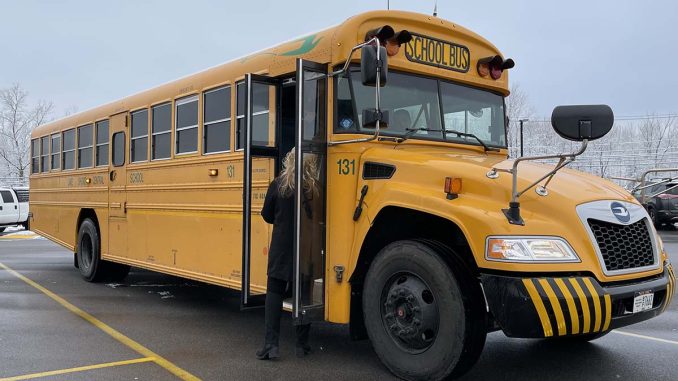
The bus ride to school is on track to get a whole lot quieter and greener, with New York State providing funding to transition school bus fleets statewide to zero-emissions vehicles by 2035.
Both Riverhead and Greenport school districts have been identified as priority districts, which means that 100% of the difference between a gas or diesel bus and a zero-emissions vehicle will be covered. The program also provides funding for chargers and the construction and installation costs associated with them.
“Starting in 2027, all new school bus purchases have to be zero emissions, and then starting in 2035 the only buses a district can have in its fleet will be zero emission,” said Nina Haiman, New York State Energy Research and Development Authority (NYSERDA) program manager of clean transportation.
The state is also encouraging every district to apply for planning assistance. Resources are available to craft an individualized plan that takes the geography, population and existing infrastructure into account. A district gets paired up with an engineering firm, either one they already work with, or one from the service list of approved contractors. That firm then helps each district create their own plan to get them into compliance by 2035. The cost of the planning is either partially or completely covered, depending on the district.
“They look at the length of their routes, how hilly their terrain is, how cold their weather is. Are their buses kept indoors or outdoors? Who’s their utility service provider? Which routes can you electrify this year? Which ones should you do in the future? Which chargers should you purchase?” Ms. Haiman said.
Besides a cleaner environment, zero-emissions buses do not expose children to harmful exhaust fumes, which can enter the cabin of a traditional gasoline- or diesel-powered bus. “The emissions from these buses do float back into the cabin of the vehicle, especially when the bus has stopped. Picking up, dropping off students at a red light, idling; those emissions get trapped in the vehicle,” Ms. Haiman said. “The fumes from diesel and gasoline vehicles have been studied. We know they are public health hazards. So there’s a real student health reason for doing this.”
Electric school buses are also better for students with sensory issues. A traditional bus is loud, jostling and has strong odors. These issues would be mitigated on zero-emissions buses, allowing those students to reconsider them as a transportation option. “It creates a much more peaceful attitude on the bus, which is certainly beneficial for safety and for drivers being able to hear what’s going on and communicate with the students, and also for those students who struggle with the overwhelming nature of a school bus ride. We’ve heard some positive feedback from communities where the students have some sensory issues and it’s helpful for them to not have the bus be so loud,” said Ms. Haiman.
The funding for the transition is being covered by a bond that was passed in 2022 as part of a package of state-wide environmental initiatives. For more information, visit nyserda.ny.gov.

